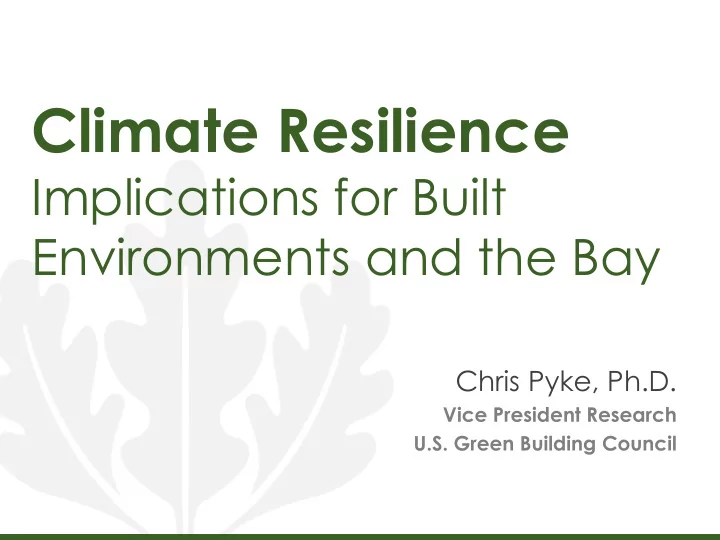

Climate Resilience Implications for Built Environments and the Bay Chris Pyke, Ph.D. Vice President Research U.S. Green Building Council
Climate Resilience
Targets x Systems x Scenarios Performance Metric Performance Metric Management Target Management Target Climate Change Climate Change Performance Metric Performance Metric Management Target Management Target Climate Change Climate Change
Systems Buildings Stormwater
Buildings : Targets & Scenarios Buildings are designed based on historic conditions e.g., Typical Meteorological Year Future conditions are unlikely to match historic assumptions e.g., minimum rise of 1.5 ° C by 2020; potential for >5 ° C
Buildings : Energy Demand Increasingly Common Typical Conditions Cool Weather Conditions Source: Franco and Sanstad (2008) Climate change and electricity demand in California
Buildings : Energy Demand Excess Energy Demand Increased Human Health Risks Increased Air Pollution Lower Passive Survivability Source : Franco and Sanstad (2008) Climate change and electricity demand in California
Stormwater : Targets & Scenarios Stormwater control strategies are based on historic design storms e.g., storm intensity, frequency Trends indicate an increased frequency of high-intensity precipitation events e.g., in New England +28% in 20 years, +127% in 90 years
Stormwater : Runoff 35 Performance under Performance in 2020 Performance in 2100 30 historic conditions Increase in pollution (kilograms/acre/year) 25 TSS 20 Phosphorus 15 Nitrogen 10 5 0 Year 1 +20 yrs +90 years Source: Pyke, Warren, et al. (2011) Assessment of low impact development for managing stormwater due to climate climate
Stormwater : Runoff 35 30 Increase in pollution (kilograms/acre/year) 25 Excess Runoff Volumes TSS 20 Excess Nutrient Pollution Phosphorus Impacts on Aquatic Ecosystems 15 Nitrogen Increasing Human Health Risks 10 Increasing Risks to Property 5 0 Year 1 +20 yrs +90 years Source: Pyke, Warren, et al. (2011) Assessment of low impact development for managing stormwater due to climate climate
Climate Resilience is… • A new dimension to everyday decisions. • An opportunity to prepare for future conditions. • Needed to meet performance targets across the lifetime of investments.
Chesapeake Bay
Chesapeake Bay Systems Water Quality • Watershed • Estuary Living Resources • Populations • Communities • Habitat
Chesapeake Bay Targets Water Quality – e.g., pollutant load allocations, designated uses, etc. Living Resources – e.g., SAV restoration, oysters, fisheries, wetlands, etc.
Chesapeake Bay Scenarios • Sea level: +0.5 to >1.0m • Temperature: +2 to >8 ° C • Annual precipitation: -10% to +20% • Winter runoff: higher • Summer runoff: lower
Chesapeake Bay Watershed Model Potential Precipitation Evapotranspiration “ Normal ” based for 18 year simulation period based on meteorological data for 1984-2002
The model uses a 10-year span of meteorological information , including a mix of wet, dry, and average rainfall years, to estimate the amounts of nutrients washed off the landscape…. The output is then averaged over the 10 years to determine the amount of nutrients delivered to streams and the Bay under “ normal ” conditions … The old model [Phase 4.3] used meteorology from 1985 through 1994, the most recent data available at the time. But a recent, longer- term analysis covering 30 years of data, found that 1985- 94 was actually about 5 percent drier than normal. A switch to using data from 1991 through 2000 [Phase 5.1], which is more representative of long-term hydrology, increases estimates of nutrient runoff-wet conditions drive more nutrients into streams …. Karl Blankenship, Bay Journal, December 2008
Monocacy Watershed Case Study Net 11% increase in N loading, variation in sensitivity to climate change: • High till agricultural land with manure application • Low till nutrient management lands • Bare construction lands • 18% of watershed, 47% of increase in total N loads Imhoff et al. 2007. Using the Climate Assessment Tool (CAT) in the U.S. EPA BASINS Integrated Modeling System to Assess Watershed Vulnerability to Climate Change
Max: +37% Min: -4%
Implications for Restoration • Pollution inputs are sensitive to climate. • Restoration strategies rely on assumptions about current and future climate. • The sensitivity of individual practices varies . • Some restoration practices offer immediate opportunities to increase resilience.
Bay Program Actions • Meet 2009 Executive Order requirements : – A comprehensive climate change assessment – Implement a plan to address climate change in decision making • Create and use new tools to identify climate sensitivities and adaptation opportunities • Create and apply new metrics to track adaptation implementation and outcomes
Recommend
More recommend